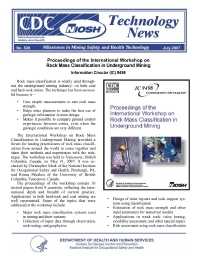Mining Publication: Technology News 526 - Proceedings of the International Workshop on Rock Mass Classification in Underground Mining
Original creation date: July 2007
Rock mass classification is widely used throughout the underground mining industry - in both coal and hard-rock mines. The technique has been successful because it 1. Uses simple measurements to rate rock mass strength. 2. Helps mine planners to make the best use of geologic information in mine design. 3. Makes it possible to compare ground control experiences between mines, even when the geologic conditions are very different. The International Workshop on Rock Mass Classification in Underground Mining provided a forum for leading practitioners of rock mass classification from around the world to come together and share their methods and experiences with the technique.
Authors: National Institute for Occupational Safety and Health
Technology News - July 2007
NIOSHTIC2 Number: 20032357
Pittsburgh, PA: U.S. Department of Health and Human Services, Public Health Service, Centers for Disease Control and Prevention, National Institute for Occupational Safety and Health, DHHS (NIOSH) Publication No. 2007-149, Technology News 526, 2007 Jul; :1-2
See Also
- Calibration and Verification of Longwall Stress Models
- Detecting and Managing Dynamic Failure of Near-Seam Features in Coal and Nonmetal Mines
- Geologic Characterization
- Overview of Ground Control Research for Underground Coal Mines in the United States
- Pillar Mechanics of Coal Mine Bursts: A Control Strategy
- Refuge Alternatives in Underground Coal Mines
- Roof Screening for Underground Coal Mines: Recent Developments
- Roof Support
- Using the Coal Mine Roof Rating (CMRR) to Assess Roof Stability in U.S. Coal Mines
- Variation of Horizontal Stresses and Strains in Mines in Bedded Deposits in the Eastern and Midwestern United States
- Wireless Mesh Mine Communication System
- Content source: National Institute for Occupational Safety and Health, Mining Program


 ShareCompartir
ShareCompartir
